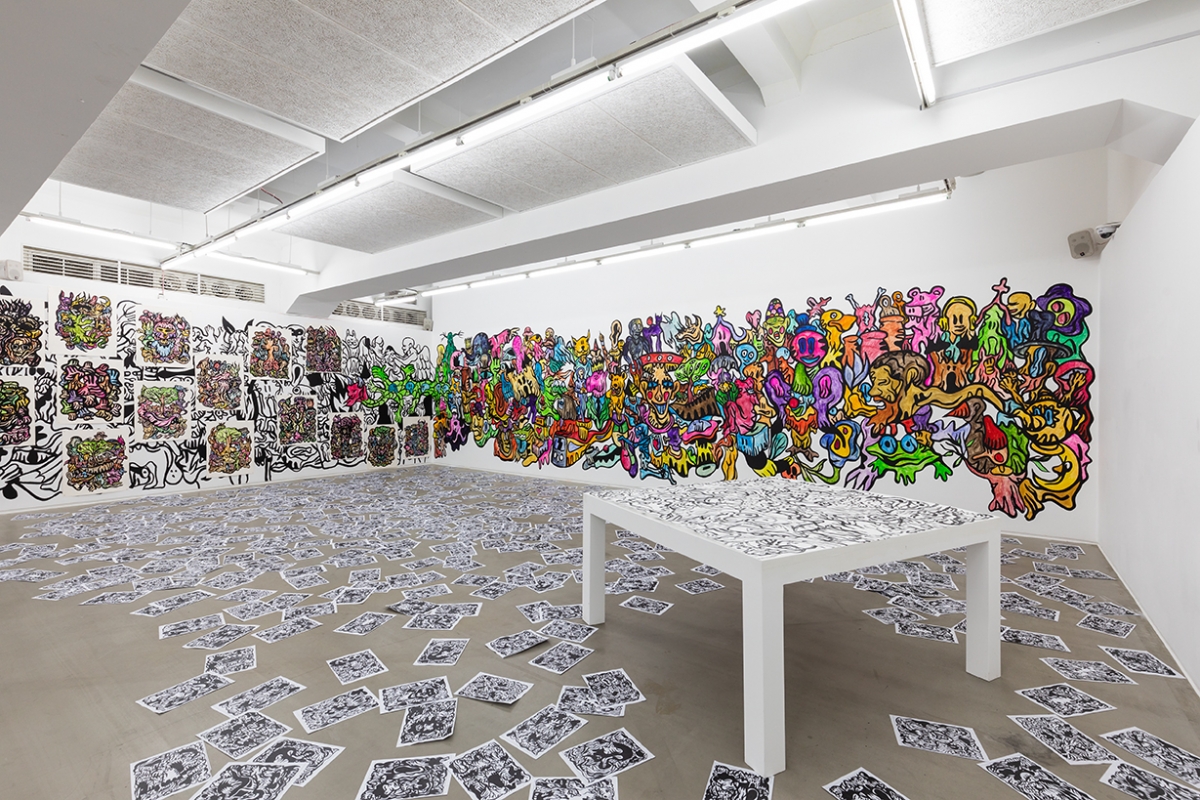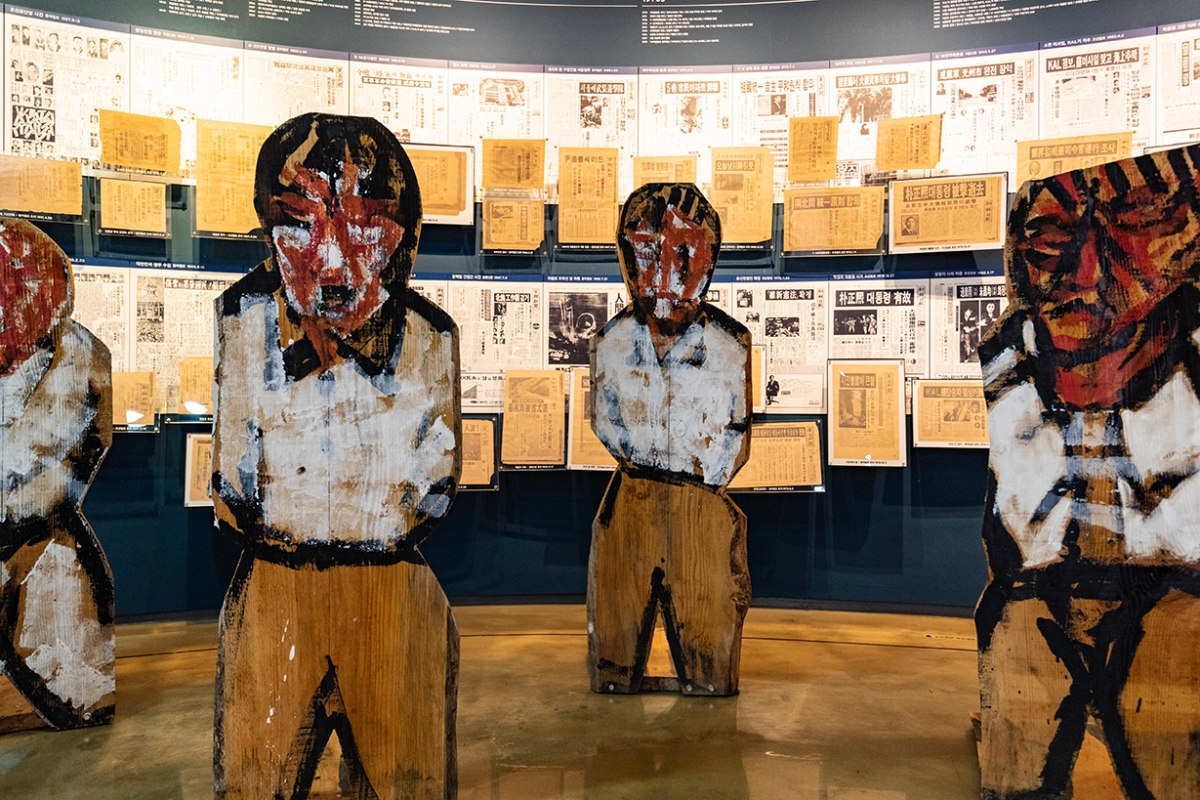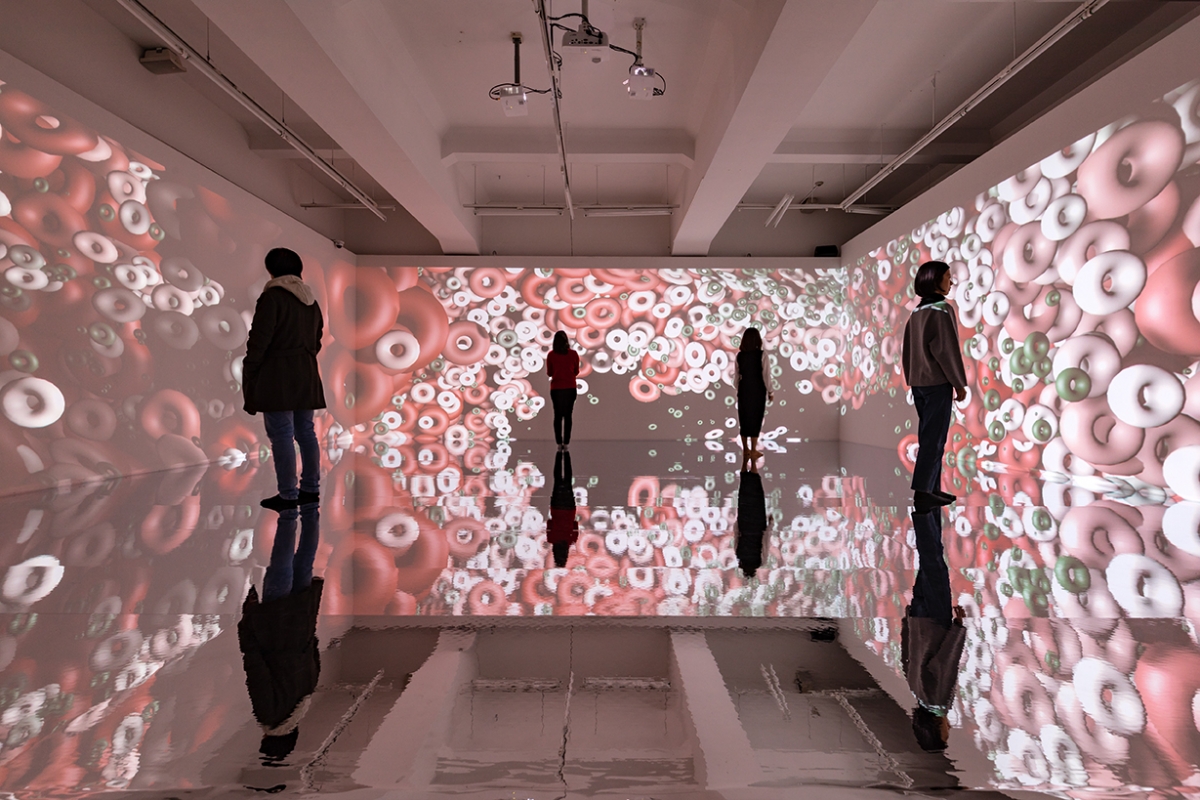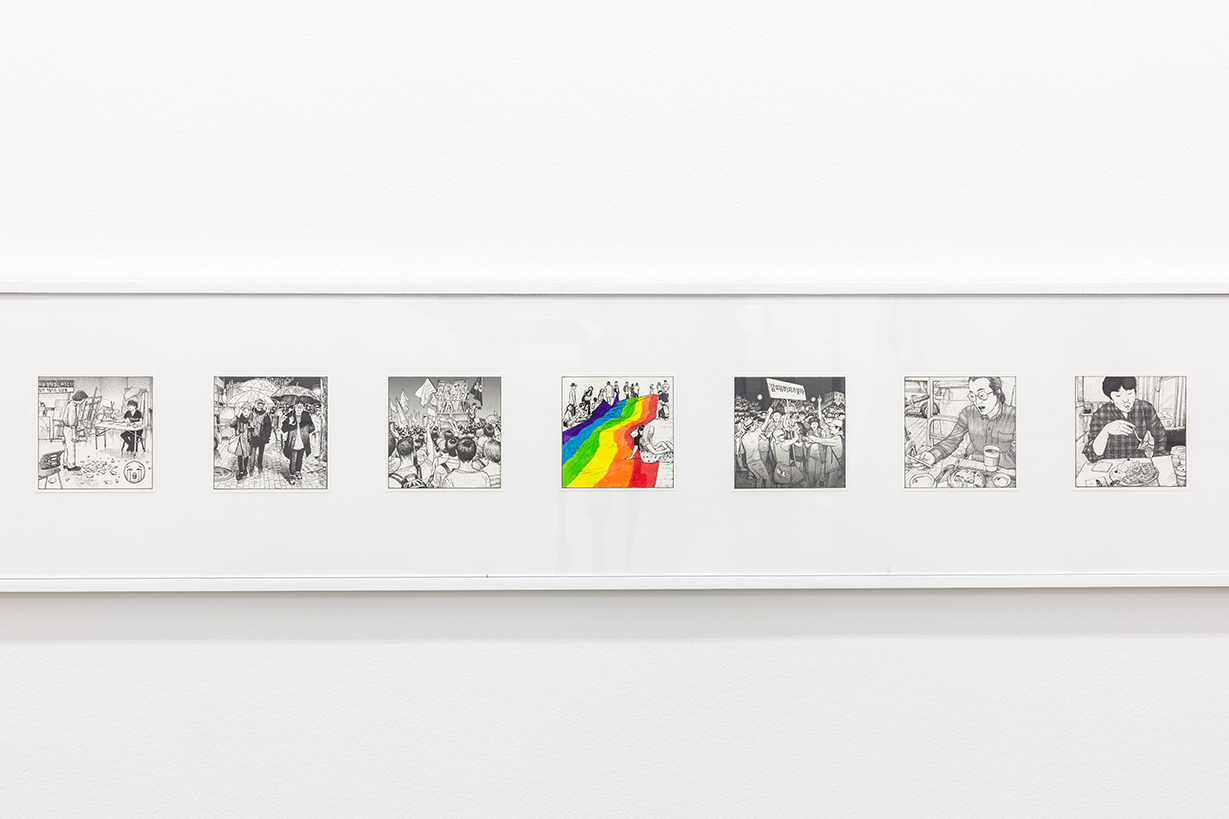‘Immortality in the Cloud’, on display at the Ilmin Museum of Art, explores how history adopts new conventions under the conditions of contemporaneity through various works from painting to virtual reality. The six visual artists in this exhibition analyse unrecorded facts, give voice to the unvoiced, or compose a narrative questioning the orthodox views of history. Such attempts broaden our understanding of history and make it look at time from different angles.
Mythical Imagery in the Museum
Entering the gallery on the first floor, a crowd of figures fill the walls. Big-eyed frogs, mushrooms with mouths, mice with human faces, winged monsters; the images that appear in fairy tales seem to glow with colour – Everyday is Your Birthday project by Fabien Verschaere has explored human existence and history through mythic motifs. Not only did he draw on the walls, but he also painted various images including Korean papers, desks, and a balloon pillar. He travelled to Seoul, Busan, and Jeju Island to prepare the exhibition, and illustrated the picture book containing figures like religious crosses, a dolharubang (a unique stone statue of Jeju Island), and various impressions that he received from the journey. His paintings appear to unfold endlessly, as far as the page permits. This might be related to the way that he draws. In the video of his working, the forms follow the brush strokes and flow. Just as a storyteller tells a story by varying the formula, Verschaere fills the canvas by calling upon his figures. Their placement is determined by brush strokes and a wandering mind, prior to planning an overall outline.
The painting of Verschaere is paired with those of Suh Yongsun, drawing similarities in terms of their imagery. The attitude of those two artists, however, is different. If the former deviates from the modern style of the historical narrative, the latter interferes with the written history in order to confuse it. Suh has drawn upon and revived fragments of Korean history that had been subdued or alienated from his paintings of many historical memories and mythological symbols. In the exhibition, he used Presseum, a newspaper museum, on the fifth floor of the building, as a gallery for his works. His paintings and sculptures modify the narratives of the museum, which offer a clear and concise arrangement of the history of newspapers in Korea; in the display case of modern newspapers from the early 1900s, paintings depicting the faces of soldiers wearing iron hats are placed side by side; and mythological beings such as Mago, Pangu, Xiwangmu appear as if they are historical materials against the background of press photographs that capture the main scenes of modern history. From the wooden statue at the entrance to the museum to the oil painting in the section that reproduces the desks of reporters in the 1950s and 1960s, this monotonous museum is filled with emotions. It is probably because the distorted figures and the abundant colour of Suh’s work touch upon the ups and downs of the recent and modern Korean peninsula and the collective sentiments of these events.
A Timeline for Yesterday and Today
On the second floor of the gallery, Lee Woosung’s work leads the viewer to the same period. Night, Walk, Memories, 303 drawings of his life on a square and palm-sized paper, which looks like a photo journal left on Instagram. The drawings run along the wall, one by one, depicting compact scenery: a sea that went to see someone, an apartment complex in summer, a cake with an anniversary candle. In the middle of these are scenes in the dream, reminiscence of historical events like candlelight vigils and impeachment of a president. The form of a black pen-drawn miniature painting and its everyday appearance create a feeling of nostalgia, as if viewing the flow over days of social media timelines in which memories from several years ago are prompted by computer algorithms. There is no such thing as a long-standing stream of time, rolling since ancient times or a historical advancement toward the better future. Just ordinary and fragmentary things are formed by the little rhythm of life.
Next to this soft emotional space lies Cho Eunji’s performance installation, “Dtang, Dtang, Dtang”, The Mud Said, which launches a clump of dirt onto a white cloth. The artist, who has been paying attention to the ‘performing act of time’, creates works that ‘lead us to encounter an individual and the reality alienated not only from the collective violence but also the collective violent memory’. In addition to the performance installation mentioned earlier, the exhibition also features A Portrait of a Woman with a Black Umbrella, a video portrait of a woman who survived the massacre in Indonesia. After showing the full body of the interviewee in the introduction, it reflects only parts of her body, including her hands, legs, and one side of the face. There is no literal translation of the interviewee’s statement, only the dancers’ mime plays inserted into the interview in its place, attempting to deliver some semblance of meaning. The tremors and tempestuous gestures of the body in the video work testify to something, and the meaning cannot be cleared out by words and sentences. The memory of violence on the body is hard to verbalise fully. The artist’s expression, ‘I trust more memories engraved with body movements than those uttered in language’, can be understood in this context.
An Individual Enumerated in Data
The works that have been mentioned so far have used traditional media such as painting, sculpture, and body (performance). However, the days in which we live are based on digital technology. Daily life is not lived only in reality but also in virtual space connected by a smartphone. Examining the ‘conventionalization of history’ under the conditions of contemporaneity requires an exploration of digital technology.
Kwon Hayoun, who has been exploring the ‘bilateral relationship between reality and fantasy’ by using virtual reality as a medium, will introduce 489 and The Bird Lady. In the exhibition, The Bird Lady is being projected onto the screen, but both works allowed viewers to experience virtual space while wearing devices. In a world where one does not feel gravity and the point of view changes as if it floats in the air, events are automatically played here according to the programme entered or appeared and disappeared according to the viewer’s position. It is a temporal and spatial experience similar to that of a game. In this virtual world, what would the history we knew be reduced to? If an individual, a so-called the agent of history becomes a game player, how do the incidents of history become a kind of ‘quest’ that the player can clear? At least, under such conditions, it is unlikely that the ‘distortion of history or facts’, a theme of the artist’s work will be accepted as a serious issue to the audience; the critical activity of rewriting history, however, becomes a kind of fun activity from which new possibilities might arise.
Kang Yiyun introduces Continuum, a projection installation that uses computer codes and algorithms. When visitors open the curtain and enter a dark space, they face images from three projectors. The images are made up of constantly changing figures, from cubes and doughnuts to columns and lines, but specific meaning and logical relationships cannot be gleaned from this – there is only transformation. The giant cube splits into small pieces, forming a cloud mass, then turning into a shape of a doughnut, also traveling rapidly from one wall to the other; its distracting movement reflected on a mirror plate fills the floor to create a kind of illusion in the space. A two-dimensional image projected onto a wall looks three-dimensional. Visitors are engulfed in images in the exhibition space and are paralyzed by the movement beyond their perceptual abilities. Through this work, the artist argues that ‘those who are not buried in the system are important’. It is hard to sympathize, because the technologies around us are overwhelming, and we already form a system where a vast amount of data is generated and collected. It is the construction of Continuum where neither the space nor the time flow of yesterday can be felt. What moves autonomously here is not the audience who looks vacantly, but the system that creates images of continuum that are repeated, expanded and reproduced in many ways.








